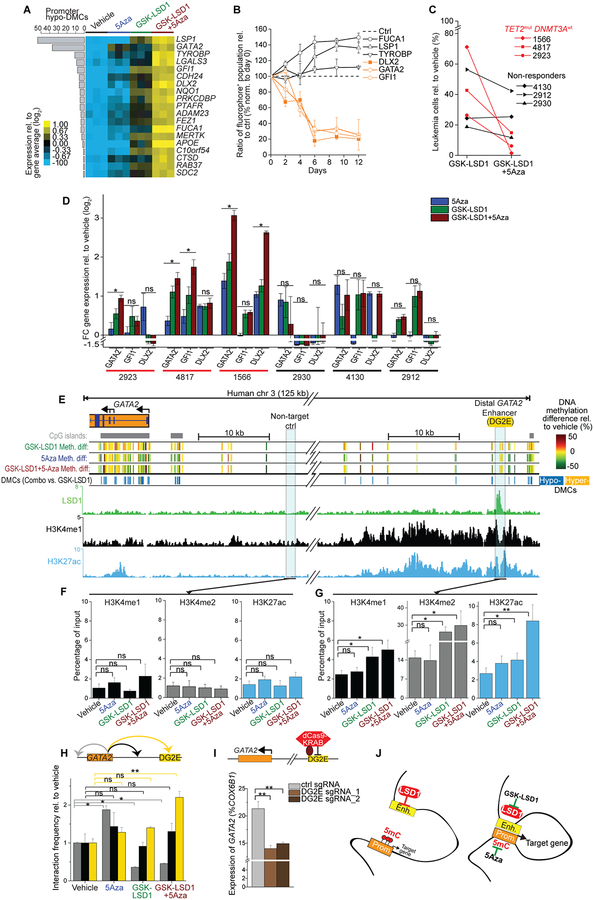Figure 5.
Cooperative gene induction through promoter-enhancer activation. A, Heat map of RNA-seq data depicting candidate genes preferentially upregulated by GSK-LSD1+5Aza treatment (log2 FC ≥1.5, RPKM ≥5) that were not passing the threshold by monotherapy treatment alone in patient-derived TET2mut AML1566 cells at day 8 (n=3 per treatment). Gene expression changes relative to total average were ranked by hypo-DMCs at promoters. B, Competitive proliferation experiment in TET2mut AML cells with overexpression of candidate genes (DLX2, FUCA1, GATA2, GFI1, LSP1, and TYROBP) and GFP control. Shown is the ratio of candidate gene-GFP+ fraction compared to empty-GFP+ relative to the initial measurement. Error bars represent means ± s.d. from three replicate plates. C, Shown are TET2mut+DNMT3Awt AML samples (red) vs non-responder samples (black) that exhibited less additional impairment after combination therapy compared to GSK-LSD1 monotherapy. D, Log2 fold change (FC) of gene expression of GATA2, GFI1 and DLX2 in TET2mut+DNMT3Awt (red, n=3) and non-responder AMLs (black, n=3) after treatment rel. to vehicle condition. qRT-PCR analysis normalized to COX6B1. Asterisk declares combination therapy as significant for the target gene compared to both monotherapies (*P≤0.05, Student’s t-test, means of triplicate measurements ± s.d.). E, Integrative scheme of ChIP-seq and ERRBS at the GATA2 locus in patient-derived TET2mut AML cells. Upper panel showing CpG methylation changes after treatment (rel. to vehicle) as well as DMCs after combinatorial treatment vs. GSK-LSD1 monotherapy. Lower panel showing ChIP-seq tracks for H3K4me1, H3K27ac, and LSD1 at the distal GATA2 enhancer (DG2E). F, G, QChIP for H3K4me1 (left panel), H3K4me2 (middle panel) and H3K27ac (right panel) at a non-target (F) and LSD1-bound DG2E (F) site. Results of each treatment at day 8 presented as percentage of its input from three independent experiments (Student’s t-test; *P<0.05, ** P<0.01). H, Q3C performed to detect chromatin-chromatin interactions of the GATA2 promoter with DG2E as well as with down- and upstream intergenic regions. Q3C results from two independent experiments performed in TET2mut AML cells after treatment with vehicle condition set as 1 on day 8 (Student’s t-test; *P<0.05, ** P<0.01). I, QPCR results for GATA2 after combination therapy on day 8 in CRISPRi-transduced TET2mut AML cells containing two sgRNA against DG2E and a non-target ctrl sgRNA (means of n=3 with s.d.; Student’s t-test; **P<0.01). J, Proposed concept of the dual targeting in AML responsive to combinatorial treatment. Removal of 5mC promoter methylation by 5Aza treatment combined with LSD1 inhibition (GSK-LSD1) facilitates stronger interactions of the LSD1-occupied enhancers with the target promoter resulting in greater induction of target genes such as GATA2.

